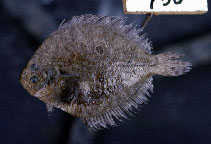| Family: |
Paralichthyidae (Large-tooth flounders) |
| Max. size: |
15 cm SL (male/unsexed) |
| Environment: |
demersal; marine; depth range - 17 m |
| Distribution: |
Indo-West Pacific: India and Sri Lanka to western Thailand, Sumatra and the southern islands of Indonesia, and northwestern Australia. |
| Diagnosis: |
Dorsal spines (total): 0-0; Dorsal soft rays (total): 65-70; Anal spines: 0-0; Anal soft rays: 49-52. Body brownish, with 1 ocellus above and below lateral line and 1 ocellus on posterior third of straight section of lateral line. Many indistinct spots and blotches on body. Pectoral fin on ocular side with 11-12 soft rays (Ref 9774). |
| Biology: |
Found on the muddy and sandy bottoms of the continental shelf. Feeds on benthic organisms. Sold fresh and dried salted in markets. |
| IUCN Red List Status: |
Least Concern (LC); Date assessed: 08 March 2021 Ref. (130435)
|
| Threat to humans: |
harmless |
Source and more info: www.fishbase.org. For personal, classroom, and other internal use only. Not for publication.

